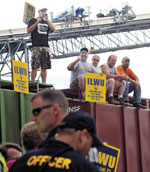
Showdown on West Coast Docks: The Battle of Longview
(November 2011).
click on photo for article
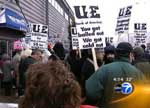
Chicago Plant Occupation Electrifies Labor
(December 2008).
click on photo for article
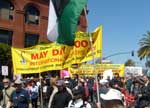
May Day Strike Against the War Shuts
Down
U.S. West Coast Ports
(May 2008)
click on photo for article

October 2015
Immigrant Workers Show the
Power of Solidarity
Victory to
the B&H Photo
Warehouse Workers’ Struggle!
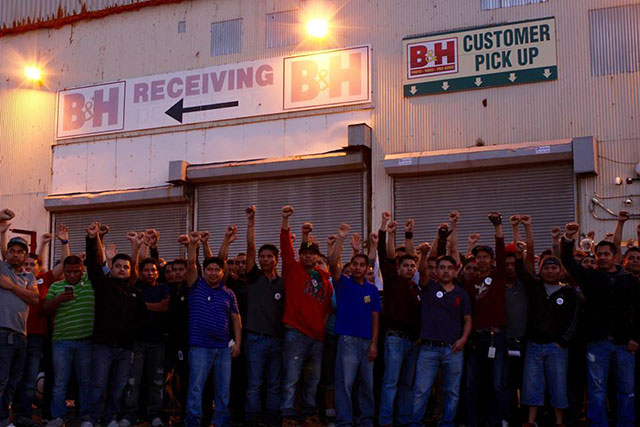
Workers at the Evergreen Ave. warehouse of B&H Photo in Brooklyn held solidarity demonstration October 15 immediately upon hearing that workers at Navy Yard warehouse were threatened with mass firing.
(Photo: Laundry Workers Center)
“We’re fighting for our future. We want dignity, respect. We’re human beings, not animals,” declared an immigrant worker on the night of October 15 as he stood outside the B&H Photo warehouse in the Brooklyn Navy Yard. A company representative had just smashed his cell phone because he was recording the anti-union rampage of bosses who ordered him and 150 of his fellow workers out of the workplace. B&H bosses were lashing out against the union organizing drive the workers had launched publicly four days previously.
Refusing to go along with the company’s peremptory demand to “sign papers” counterposed to the organizing drive, the workers were threatened with mass termination. Hearing this news, workers at the company’s other Brooklyn warehouse reacted immediately with a solidarity demonstration. The bosses backed down, announcing all could return to work the next morning. With their extraordinary unity and determination, the B&H warehouse employees showed the power of workers’ solidarity. For supporters of labor and immigrant rights, it was a night to remember.
“What Do We Want? Union!”
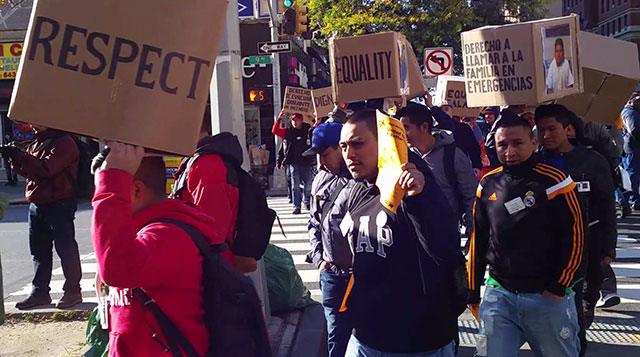
Some 200+ B&H warehouse workers marched on October 18, chanting “On Thursday [October 15] we showed that we are not afraid!” (Internationalist photo)
The immigrant warehouse workers, some of whom have been with B&H for as long as 17 years, work in strenuous and hazardous conditions. They are forced to work 12-17 hour days with no breaks, and no overtime pay. A mere five to ten minutes to eat, if that, constitutes a “meal break.” Bathroom breaks can result in being sent home early, and they are unable to use their cell phones to contact family members during emergencies. Many of the workers suffer from chronic nosebleeds, back pain, migraines, and fatigue from poor ventilation and exposure to harsh chemicals. Lack of proper safety equipment and training contribute to multiple physical injuries. Workers are not given hard hats, goggles or gloves, and are as a rule not allowed to use forklifts or jacks to move heavy objects. If workers do use forklifts or jacks, they do so without any proper training and often suffer injuries.
At B&H, which boasts that it is the largest non-chain photo and video equipment store in the United States, racist treatment is a standard part of the workday at a company where workers face discrimination so blatant that B&H was forced to pay $4.3 million to settle an Equal Employment Opportunities Commission lawsuit for “national origin discrimination” in 2007. Other suits have accused the company of withholding health benefits, a generally abusive work environment and gender discrimination. A longstanding policy has been to not hire any women warehouse workers at all.
Publicly launched at the October 11 rally which brought out upwards of 300 workers, family members and supporters, the unionization campaign at B&H has been building for over a year. It is one of the biggest current efforts to organize immigrant workers in the New York area. Faced with rampant discrimination and total disregard for their health and safety, workers came to see organizing as literally a matter of life and death when a fire broke out next to the Navy Yard warehouse last year. Management refused to let workers leave the premises until they had gone through a “security check” one by one.
The B&H workers were inspired by the 2012 victory of immigrant bakery workers at the Hot and Crusty store in midtown Manhattan. The brother of one of the B&H workers, Raúl Pedraza, worked at a cleaners nearby and suggested they get in touch with the Laundry Workers Center (LWC), a labor rights group that initiated the Hot and Crusty campaign, through which workers organized their own union and even won a union hiring hall. As we wrote at the time, this solid labor victory “drew attention to the enormous potential for wide-ranging, militant organizing among immigrant workers in New York and beyond. Super-exploited, doubly and triply oppressed and largely disenfranchised, these workers – mere raw material for exploitation from the standpoint of the ruling class – could be sparked into struggle by even a localized victory” (“Hot and Crusty Workers Win With Groundbreaking Contract,” The Internationalist, November 2012). Today, the B&H struggle points the way for such a class-struggle counteroffensive.

Hundreds of B&H workers and supporters turned out on Sunday, October 18 in an impressive show of strength, vowing that the attempted mass firing would not stop struggle. The crowd chanted, “¡Unión, fuerza, solidaridad!” (union, power, solidarity). (Internationalist photo)
Working with the LWC, B&H workers have now organized a solid drive to be represented by the United Steelworkers, which filed for a union representation election on October 13. This came hard on the heels of the October 11 rally, where workers’ representatives, accompanied by a delegation of supporters, handed a letter of grievances to management, followed by a flood of warehouse employees chanting in the aisles of the store while hundreds shouted encouragement on the sidewalk outside. Desperate to stop the organizing campaign, B&H has hired Jackson Lewis LLP, described by one former federal official as “a key player in the union avoidance industry,” famed for its “aggressive anti-union campaign[s]” (New York Times, 14 December 2004). Thus it was that on October 15 the company launched its rampage of retaliation at the Navy Yard warehouse, with one manager declaring: “There will not be a union – over my dead body.”
“What do we want? Union! When do we want it? Now!” chanted the crowd of almost 200 gathered outside the warehouse gates that night. One of the workers who refused to sign the bosses’ anti-union “paperwork” said that at first “we felt alone” when faced with their threats. “But when we saw that everyone was supporting us, we didn’t feel alone anymore. We felt protected” by fellow workers and supporters of the campaign. An Internationalist speaker told the gathering:
“As Don Quijote said to his friend Sancho Panza: ‘If the dogs are barking, it is because we are advancing.’ It is because you are advancing that the dogs are barking.... The bosses are afraid of you, because you are not afraid of them; because with the union, with the strength, with the unity and militancy of the workers, with workers’ consciousness, you will win, and you will give an example to all the working class of this city. ¡Adelante, compañeros!”
“La lucha obrera no tiene fronteras”
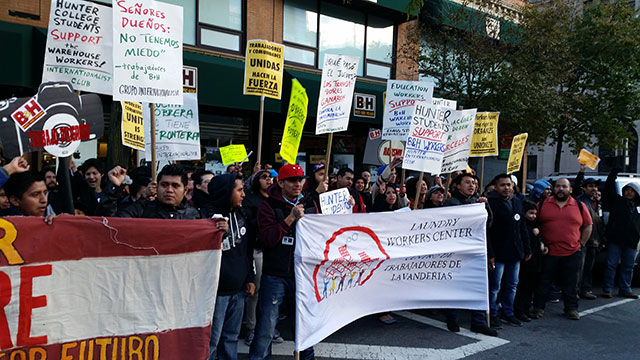
CUNY Internationalist Clubs and Internationalist Group supporting workers at the October 18 protest outside B&H. (Internationalist photo)
Drawn predominantly from Mexico, Guatemala and the Dominican Republic, the B&H warehouse workers exemplify the enormous potential for class struggle by the multinational working class of New York and beyond. Like immigrants across the country, they are fed up with being treated as pariahs, scapegoats and beasts of burden for the capitalists. Showing the power of workers’ solidarity in practice, their fight can help ignite a struggle by immigrant and U.S.-born workers alike after years and decades in which the owning class has grown ever richer through increasing exploitation and inequality, bringing poverty, discrimination and racist cop and “Migra” (immigration police) terror against the workers and oppressed.
Addressing the October 11 rally, an immigrant worker who is a spokesman for the Internationalist Group said: “The capitalist class says we are criminals, but they are the criminals. Ni ilegales, ni criminales, somos obreros internacionales. [We are neither illegals nor criminals, but international workers.]... It is the working class that has the power to shut this system down.” While Republican Donald Trump grabs headlines with his anti-immigrant ravings, Obama has deported over two million immigrants and his would-be successors from the Democratic Party follow in his footsteps. Against all the capitalist parties and politicians, we fight for full citizenship rights for all immigrants.
To maintain their system of exploitation, our comrade noted, the capitalists always seek to divide the working class. They set workers of different ethnicities or languages against each other here, the Internationalist speaker noted, while in the Dominican Republic the ruling class is carrying out a campaign of deportations against people of Haitian descent. Bringing labor’s power to bear against every form of oppression is crucial. Against any attempt to smear the B&H struggle as “Latinos vs. Jews” (the owners are Hasidic, as is much of the sales personnel), the October 11 rally featured solidarity greetings from a rabbi and from Jews for Racial and Economic Justice, among the many groups supporting the workers’ struggle.
The power of workers’ solidarity was demonstrated by the B&H workers as they put a quick stop to the bosses’ threatened mass firing on October 15. And as we wrote during a previous struggle by warehouse workers in Brooklyn: “The immigrant workers in Brooklyn must not stand alone. All of New York City labor should come to their aid.... If we act together, we have the power to win!” (“Mobilize NYC Labor to Defend Brooklyn Immigrant Workers!”, Internationalist leaflet, February 2007). Today, a key component for winning the fight at B&H is bringing out the power of major unions in the New York area, such as Verizon phone workers, Teamsters, the building trades, teachers, Con Ed workers and others.
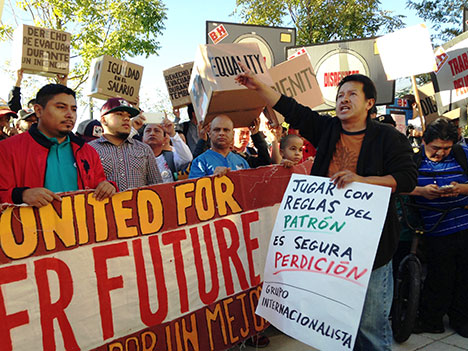 Internationalist worker at October 11 rally
kicking off unionization drive. “Playing by the bosses’
rules is a losing game.” (Internationalist photo)
Internationalist worker at October 11 rally
kicking off unionization drive. “Playing by the bosses’
rules is a losing game.” (Internationalist photo) “New York is a union town” is a slogan often chanted at labor rallies. But if you don’t use it, you lose it, as shown by all too many defeats brought by labor bureaucrats who chain the unions to the bosses’ Democratic Party. Unchaining that power means, for starters, using the tactics that built the unions in the first place – like bringing out real labor solidarity in mass pickets to stop attempts to prevent workers from exercising their basic right to organize. Today the B&H struggle shows both the potential and the need for a class-struggle leadership of NYC labor to bring that power to bear.
At the October 11 rally, a United Steelworkers spokesman stated that the B&H struggle shows the need to organize against the ravages of “the capitalist system that is crushing the working class.” True enough. From the warehouses of Brooklyn to Ayotzinapa in Mexico, that system means suffering and oppression for the workers and oppressed. But as Karl Marx said, capitalism has created its own gravediggers: the international working class. In the words of the Internationalist chant: ¡Luchar, vencer, obreros al poder! (Fight, win, workers to power!)
B&H warehouse worker Jorge Lora was quoted in the press expressing the hope that the organizing campaign will “inspire other low-wage workers with the idea that ‘unity is strength’,” since “workers have the power because in the city, nothing can move” without their labor. With the inspiring example of the B&H workers’ own unity and determination, the workers movement, backed by all defenders of labor and immigrant rights, must use that power to help the workers win this fight.
Victory to the workers of B&H!